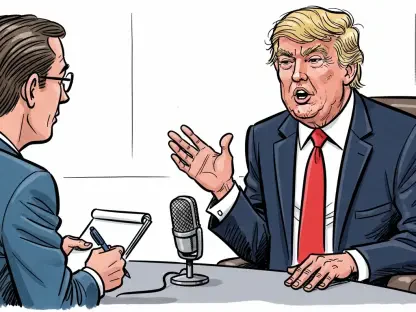Imagine a critical government department tasked with safeguarding workers’ rights and economic stability, yet its technology backbone is crumbling under staffing losses and leadership uncertainty. This is the reality at the U.S. Department of Labor, where the recent departure of acting Chief Information Officer (CIO) Thomas Shedd has spotlighted deep-seated challenges in federal tech operations. This roundup gathers diverse perspectives from industry observers, government insiders, and policy analysts to dissect the implications of Shedd’s exit, explore the chaos within Labor’s tech office, and uncover broader lessons for federal agencies. The goal is to illuminate the path forward during a pivotal moment of transition and reform.
Diverse Perspectives on Shedd’s Departure
Insights from various stakeholders paint a complex picture of Thomas Shedd’s exit from his temporary role at Labor. Industry watchers familiar with federal tech transitions note that Shedd, a former Tesla engineer and current leader at the General Services Administration’s Technology Transformation Services, faced an uphill battle balancing dual roles. Many argue that his abrupt departure, announced on a Friday evening and communicated to staff shortly after, signals underlying tensions rather than a planned exit strategy.
Government employees within Labor, speaking anonymously to protect their positions, express mixed feelings about the leadership change. Some view Shedd’s tenure as a missed opportunity to stabilize operations, citing his lack of deep engagement with the department’s specific needs. Others, however, acknowledge the broader constraints of temporary roles, suggesting that expecting long-term impact from a short-term leader may be unrealistic in the current administrative climate.
Policy analysts focusing on federal workforce trends offer a wider lens, pointing out that Shedd’s exit is emblematic of a recurring issue: the challenge of retaining specialized talent in government. They emphasize that overlapping responsibilities, as seen with Shedd’s ongoing GSA duties, often dilute focus and hinder progress. This diversity of opinion underscores the need to examine not just individual leadership but systemic structures that shape such transitions.
Unpacking Labor’s Tech Office Struggles
Staffing Crisis: A Barrier to Efficiency
A staggering loss of over 40% of tech staff at Labor, compounded by a department-wide reduction of 20%, has drawn sharp commentary from multiple sources. Reports from mainstream outlets highlight that voluntary exits, often tied to policy shifts in recent administrations, have gutted critical expertise. Observers of federal employment trends argue that this mass departure has left remaining teams overwhelmed, unable to maintain basic operational tempo.
Current and former staff members, sharing their experiences through industry forums, describe a workplace paralyzed by inefficiencies. They point to halted projects and the constant need to justify even minor expenses as key frustrations during Shedd’s stint. These accounts suggest that the staffing crisis isn’t merely a numbers game but a profound hit to morale and productivity, with ripple effects on service delivery.
Analysts of government operations add that such turnover isn’t unique to Labor but reflects a broader pattern across agencies. They debate whether leadership changes exacerbate the problem or if deeper cultural resistance to adaptation is the root cause. This mix of firsthand frustration and analytical perspective reveals a department struggling to function under the weight of its own diminished capacity.
Bureaucratic Hurdles: Stifling Innovation
Bureaucratic red tape emerges as another focal point in discussions about Labor’s tech challenges, with insights gathered from various federal watchdogs and media analyses. Reports indicate that delays in approving essential purchases, such as website security certificates, have led to preventable service disruptions. This bottleneck, often tied to stringent budget oversight, mirrors obstacles seen in other government bodies striving for fiscal restraint.
Staff sentiments, echoed in internal feedback shared with policy groups, reveal the human cost of these delays. Employees describe countless hours spent addressing issues that could have been avoided with timely approvals, painting a picture of wasted resources and growing disillusionment. These firsthand accounts highlight how administrative barriers directly undermine the department’s mission to support American workers.
Commentators on federal efficiency question the logic behind prioritizing short-term savings over long-term stability. Many argue that the focus on cutting costs has backfired, creating larger expenses through lost services and eroded trust. This critical viewpoint suggests that without a shift in approach, Labor—and similar agencies—risk perpetuating a cycle of dysfunction under the guise of fiscal responsibility.
Leadership Gaps: Uncertainty Looms
The absence of a permanent CIO following Shedd’s departure has sparked concern among those tracking federal tech leadership. Observers note that temporary appointments, while sometimes necessary, often fail to provide the strategic vision needed for lasting change. This sentiment is particularly strong given Labor’s current state of flux, where uncertainty amplifies existing operational woes.
Industry voices focusing on tech governance point to Shedd’s dual role at GSA as a cautionary tale of overextension. They argue that splitting attention across agencies, especially during a push for innovations like AI adoption, can dilute effectiveness and leave critical gaps unaddressed. This perspective raises questions about the viability of interim leadership in high-stakes environments like Labor’s tech division.
Policy experts add that the leadership vacuum at Labor reflects a broader trend of delayed permanent appointments across government. They suggest that without a dedicated, long-term CIO, initiatives risk stalling amid staff cuts and shifting priorities. These varied insights collectively underscore the urgency of establishing stable, focused leadership to navigate the department through its current turmoil.
Systemic Challenges Across Federal Agencies
Labor’s struggles are not an isolated case, as numerous sources point to parallel disruptions in other federal entities. Analysts of government operations highlight a widespread loss of institutional knowledge due to attrition, compounded by new administrative hurdles introduced in recent years. This pattern, they argue, threatens the ability of agencies to adapt to modern demands like digital transformation.
Feedback from employees across multiple departments, shared through professional networks, reveals a shared frustration over wasted resources and stalled progress. Many describe a disconnect between leadership’s cautious optimism and the ground-level reality of understaffed, overburdened teams. This contrast in perception suggests a deeper cultural divide that transcends any single agency or leader.
Think tanks studying public administration speculate on whether these systemic issues signal a need for structural reform or merely a temporary rough patch. Some advocate for overhauling hiring and retention policies to rebuild expertise, while others believe streamlined processes could mitigate current pain points. This range of opinions reflects the complexity of addressing challenges that span beyond Labor’s walls into the broader federal landscape.
Key Takeaways for Federal Tech Stability
Synthesizing the insights from industry observers, government staff, and policy analysts, several critical themes emerge around Labor’s tech office turmoil. The consensus points to Shedd’s exit as a symptom of larger issues, including massive staff turnover, bureaucratic inefficiencies, and the pitfalls of temporary leadership. These challenges have collectively hampered the department’s ability to deliver on its mission.
Recommendations from various stakeholders focus on actionable steps to restore balance. Many emphasize the urgent need for a permanent CIO to provide consistent direction and rebuild trust within the tech team. Others advocate for revising expenditure approval processes to prioritize operational needs over rigid cost-cutting, ensuring that essential services aren’t sacrificed in the name of savings.
Additional suggestions include fostering a culture that values institutional knowledge through better retention strategies. Commentators across the board agree that federal leaders must strike a delicate balance between fiscal responsibility and technological resilience. These diverse tips offer a roadmap for not only Labor but also other agencies grappling with similar disruptions in an era of heightened scrutiny and change.
Reflecting on the Path Forward
Looking back on the discussions surrounding Thomas Shedd’s departure and the broader tech turmoil at the U.S. Department of Labor, it becomes clear that the challenges are multifaceted and deeply rooted in systemic issues. The insights gathered from various perspectives paint a picture of a department—and indeed a federal landscape—struggling to adapt under the pressures of staffing losses and bureaucratic constraints.
Moving ahead, actionable solutions emerge as a beacon of hope from these reflections. Prioritizing the appointment of a dedicated, long-term CIO stands out as a critical first step to stabilize operations at Labor. Additionally, rethinking budget approval mechanisms to prevent service disruptions offers a practical way to address immediate pain points. Finally, investing in workforce retention and training promises to rebuild the expertise needed for sustainable progress, ensuring that federal tech leadership can meet the demands of an evolving public service environment.









